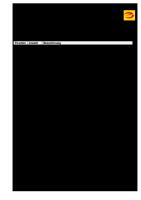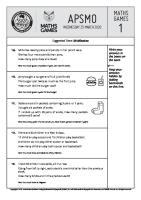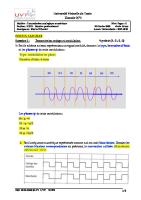2020 DS 1 [PDF]
APSMO OLYMPIAD 1 2020 : DIVISION S WEDNESDAY 25 MARCH 2020 Total Time Allowed: 30 Minutes 1A. Felicia computed 8 + 5
43 0 303KB
Papiere empfehlen
![2020 DS 1 [PDF]](https://vdoc.tips/img/200x200/2020-ds-1.jpg)
- Author / Uploaded
- Sachdev King
Datei wird geladen, bitte warten...
Zitiervorschau
APSMO
OLYMPIAD
1
2020 : DIVISION S
WEDNESDAY 25 MARCH 2020 Total Time Allowed: 30 Minutes 1A. Felicia computed 8 + 5 × 3 and arrived at the incorrect answer of 39.
Write your answers in the boxes on the back.
By how much does Felicia’s incorrect answer exceed the true correct answer? 1B. A seesaw is balanced when a weight on one side of the fulcrum multiplied by its distance from the fulcrum, is the same as a weight on the other side of the fulcrum multiplied by its distance from the fulcrum.
20 kg
← Keep your 12 kg
3 metres
x metres
Fulcrum
answers hidden by folding backwards on this line.
For the balanced seesaw shown, find the value of x in metres. [ Diagram not drawn to scale. ] 1C. In the diagram,
Q
• AB = 3 cm, • BC = 6 cm, and • CD = 9 cm. The area of ΔAQB = 6 cm2.
A
B
C
D
Find the number of square centimetres in the area of ΔCQD. 1D. There are 25 prime numbers less than 100. Some of these are two-digit prime numbers. What fraction of two-digit prime numbers contain the digit 9? Express this fraction in lowest terms. 1E. Find the least positive integer N so that the value of 2020 + N is both • a perfect cube, and • a multiple of 56. Copyright © 2020 Australasian Problem Solving Mathematical Olympiads (APSMO) Inc. and Mathematical Olympiads for Elementary and Middle Schools. All rights reserved.
APSMO 2020 : DIVISION S
WEDNESDAY 25 MARCH 2020
OLYMPIAD
1
1A. Student Name:
1C.
Fold here. Keep your answers hidden.
1B.
1D.
1E.
Copyright © 2020 Australasian Problem Solving Mathematical Olympiads (APSMO) Inc. and Mathematical Olympiads for Elementary and Middle Schools. All rights reserved.
APSMO
OLYMPIAD
1
2020 : DIVISION S
WEDNESDAY 25 MARCH 2020 Solutions and Answers
For teacher use only. Not for Distribution.
1A: 16
1B: 5
1C: 18
1D:
2 7
1E: 724
1A. Strategy: Use the Order of Operations for arithmetic. Calculate the correct answer by multiplying before adding: 8 + 5 × 3 = 8 + 15 = 23. Subtract to find the amount that Felicia’s answer exceeds the correct answer: 39 – 23 = 16. Follow-Ups: (1) How much greater is the value of (52)3 than the value of 52 × 53? [ 12 500 ] (2) What might have been the error that Felicia made to get her incorrect answer? [ She may have added before multiplying. ] 1B.
Strategy: Set up an equation. 20 × 3 = 12 × x
Since the product of the weight by its distance to the fulcrum is the same for both sides of a seesaw:
60 = 12x
x = 5 metres.
Follow-Up: Where would you need to place the fulcrum under a 10 metre plank in order to balance a 45 kg weight on one end of the plank and a 30 kg weight on the other? [ 4 metres from the end with the heavier weight. ] 1C.
METHOD 1 Strategy: Convert to a more convenient form. Construct a rectangle AQRB. Since the area of ΔAQB = 6 cm2, the area of AQRB is 2 × 6 cm2 = 12 cm2. Therefore the length of AQ is 12 cm2 ÷ 3 cm = 4 cm. Q
R
Construct a rectangle AQSC, with area 4 cm × (3 + 6) cm = 36 cm2.
Construct a rectangle AQTD, with area 4 cm × (3 + 6 + 9) cm = 72 cm2.
The area of ΔAQC is 36 cm2 ÷ 2 = 18 cm2.
The area of ΔAQD is 72 cm2 ÷ 2 = 36 cm2.
Q
R
S
Q
R
S
T
6cm2
6 cm
9 cm
C
D
4 cm
4 cm
4 cm 6 cm2 A 3 cm B
18 cm2 18 cm2
A 3 cm B
6 cm
C
9 cm
D
36 cm2 36 cm2
A 3 cm B
6 cm
C
9 cm
D
Since ΔCQD is the difference between ΔAQD and ΔAQC, the area of ΔCQD = 36 cm2 – 18 cm2 = 18 cm2. METHOD 2 Strategy: Apply the formula for the area of a triangle, and use the ratio of base to area for triangles. The area of a triangle is given by the formula Area =
1 (base 2
× height)
2 × Area = base × height height =
2 × Area base .
2 × Area(ΔAQB) 2 × Area(ΔCQD) Since the heights of all the height = Base(ΔAQB) = Base(ΔCQD) triangles are the same, 2 × 6 cm2 2 × Area(ΔCQD) 3 cm = 9 cm
Area(ΔCQD) = 18 cm2.
Follow-Up: Using the same diagram as in the problem, if BD = 12 cm and the area of ΔCQD is 3 of the area of 4 ΔBQC, find the length of BC. [ 3 cm ] Copyright © 2020 Australasian Problem Solving Mathematical Olympiads (APSMO) Inc. and Mathematical Olympiads for Elementary and Middle Schools. All rights reserved.
APSMO
OLYMPIAD
1
2020 : DIVISION S
WEDNESDAY 25 MARCH 2020 1D. Strategy: Make a list of the 2-digit primes that contain the digit 9. Consider the two-digit numbers that contain the digit 9. 1
2
3
4
5
6
7
8
9 10
11 12 13 14 15 16 17 18 19 20 21 22 23 24 25 26 27 28 29 30 31 32 33 34 35 36 37 38 39 40 41 42 43 44 45 46 47 48 49 50 51 52 53 54 55 56 57 58 59 60 61 62 63 64 65 66 67 68 69 70 71 72 73 74 75 76 77 78 79 80 81 82 83 84 85 86 87 88 89 90 91 92 93 94 95 96 97 98 99 100
Eliminate multiples of 2 and 3. 2 3 x 4 5 x 6 7 x 8 x 9 10 x x x x x x x 21 x 22 x 23 24 x 25 26 x 27 x 28 x 29 30 x 31 32 x 33 x 34 x 35 36 x 37 38 x 39 x 40 x 41 42 x 43 44 x 45 x 46 x 47 48 x 49 50 x 51 x 52 x 53 54 x 55 56 x 57 x 58 x 59 60 x 61 62 x 63 x 64 x 65 66 x 67 68 x 69 x 70 x 71 72 x 73 74 x 75 x 76 x 77 78 x 79 80 x 81 x 82 x 83 84 x 85 86 x 87 x 88 x 89 90 x 91 92 x 93 x 94 x 95 96 x 97 98 x 99 x 100 x
Eliminate multiples of 5 and 7. 2 3 x 4 5 x 6 7 x 8 x 9 10 x x x x x x x 22 x 23 24 x 25 x 26 x 27 x 28 x 29 30 x 32 x 33 x 34 x 35 x 36 x 37 38 x 39 x 40 x 42 x 43 44 x 45 x 46 x 47 48 x 49 x 50 x 52 x 53 54 x 55 x 56 x 57 x 58 x 59 60 x 62 x 63 x 64 x 65 x 66 x 67 68 x 69 x 70 x 72 x 73 74 x 75 x 76 x 77 x 78 x 79 80 x 82 x 83 84 x 85 x 86 x 87 x 88 x 89 90 x 92 x 93 x 94 x 95 x 96 x 97 98 x 99 x 100 x
1
1
11 12 13 14 15 16 17 18 19 20
11 12 13 14 15 16 17 18 19 20
x
21 31 41
x
51 61 71
x x
81 91
Since all composite numbers under 102 must have at least one factor that is less than 10, we can be sure that we have eliminated all of the composite numbers on the grid. Therefore there are 6 two-digit primes that contain the digit 9.
Of the twenty-five prime numbers under 100, four have only one digit: { 2, 3, 5, 7 }. There are 25 – 4 = 21 two-digit primes. The probability that a randomly selected two-digit prime number contains the digit 9 is therefore 6 = 2 . 21
7
Follow-Ups: (1) Let A equal the number of 2-digit whole numbers. Let B equal the number of 2-digit prime numbers that do not contain the digit 9. Compute the whole number value of A . [ 5 ] B
7
(2) Notice that 26 can be written as 5 + 6 + 7 + 8 and that 35 = 17 + 18. Many counting numbers can be written as the sum of some number of consecutive whole numbers. Find the least 2-digit number for which no number of consecutive whole numbers can equal that number. [ 16 ] 1E.
METHOD 1 Strategy: Make a list of perfect cubes. Number
10
11
12
13
14
Number cubed
1000
1331
1728
2197
2744
Greater than 2020?
No
No
No
Yes
Yes
Divisible by 56?
No (since Yes (see 2197 is odd) right)
5 6
)
4 2 7 4 2 2 4 5 0 5 0
9 4 4 4 0
The least possible perfect cube greater than 2020 and also divisible by 56 is 2744. If 2020 + N = 2744, then N = 2744 – 2020 = 724. METHOD 2 Strategy: Use prime factorisation. Factor 56 into primes: 56 = 2 × 2 × 2 × 7. Multiply both sides of the equation to make the right side a perfect cube: 56 × 7 × 7 = 2 × 7 × 2 × 7 × 2 × 7. Since (2 × 7)3 = 143 = 2744, it is the least number to satisfy the conditions. It follows that N = 2744 – 2020 = 724. Follow-Up: Find the sum of the first ten positive perfect cubes. [ 13 + 23 + ... + 103 = 3025. Note that (1 + 2 + ... + 10)2 = 552 = 3025. ] Copyright © 2020 Australasian Problem Solving Mathematical Olympiads (APSMO) Inc. and Mathematical Olympiads for Elementary and Middle Schools. All rights reserved.









